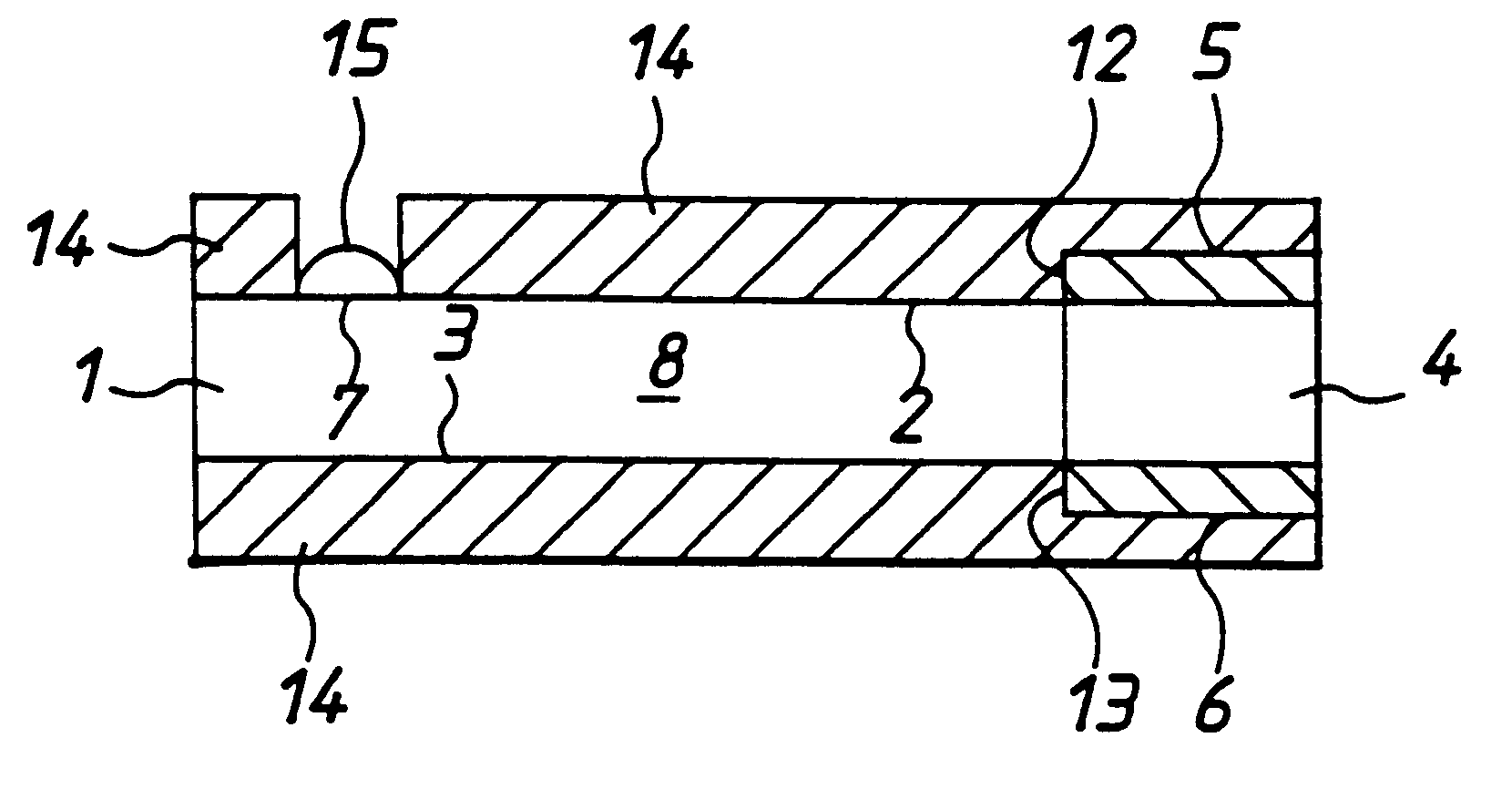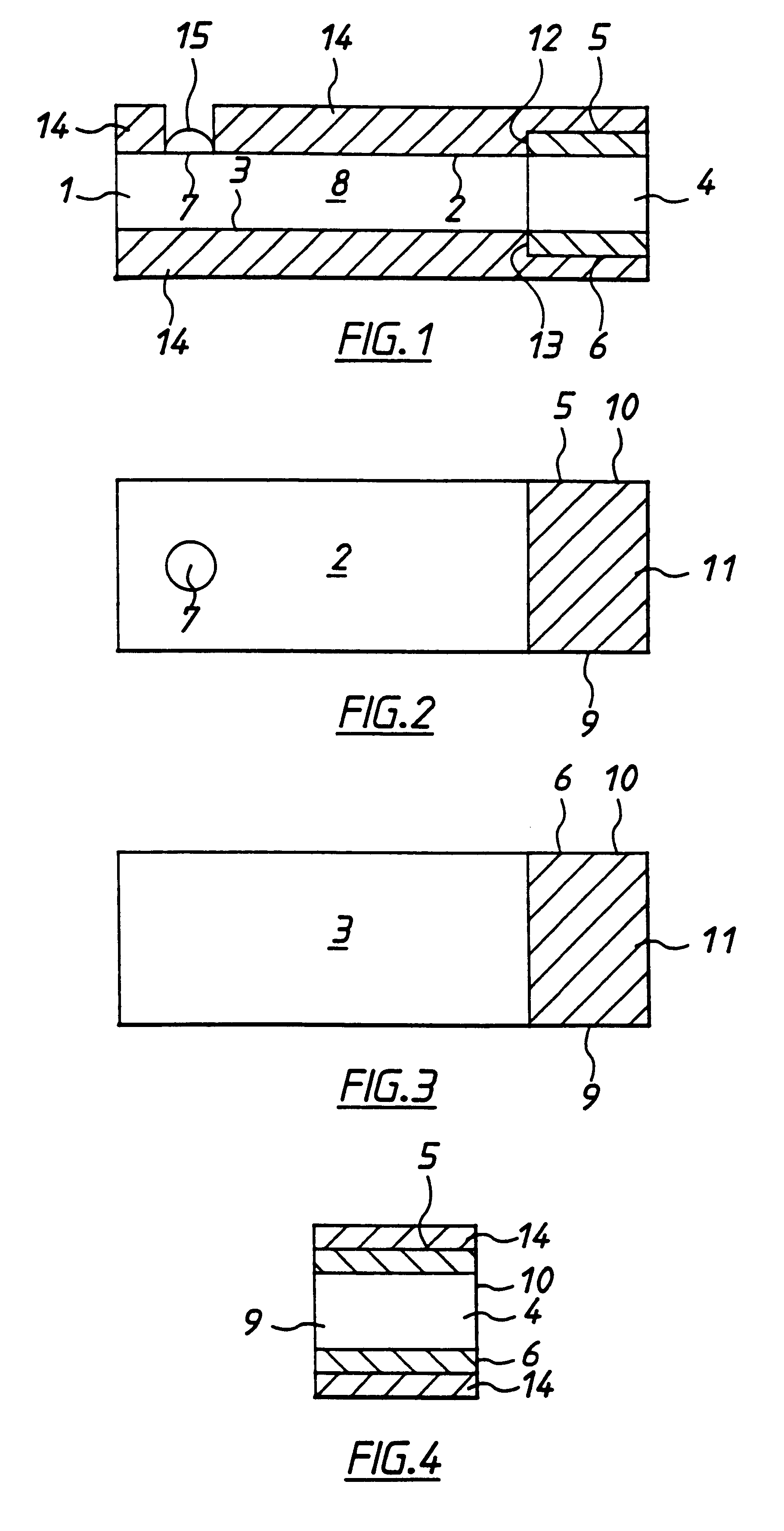Electrochemical cell
a technology of electrochemical cells and cells, applied in the field of electrochemical cells, can solve the problems of inability to achieve the intended use of sensors, interference in the determination, and inaccuracy during use, so as to improve accuracy, reliability and/or speed.
- Summary
- Abstract
- Description
- Claims
- Application Information
AI Technical Summary
Benefits of technology
Problems solved by technology
Method used
Image
Examples
first embodiment
With reference to FIGS. 1 to 4 there is shown apparatus of the invention, in this case a biosensor for determining glucose in blood. The embodiment comprises a thin strip membrane 1 having upper and lower surfaces 2, 3 and having a cell zone 4 defined between a working electrode 5 disposed on upper surface 2 and a counter electrode 6 disposed on lower surface 3. The membrane thickness is selected so that the electrodes are separated by a distance "1" which is sufficiently close that the products of electrochemical reaction at the counter electrode migrate to the working electrode during the time of the test and a steady state diffusion profile is substantially achieved. Typically, "1" will be less than 500 .mu.m. A sample deposition or "target" area 7 defined on upper surface 2 of membrane 1 is spaced at a distance greater than the membrane thickness from cell zone 4. Membrane 1 has a diffusion zone 8 extending between target area 7 and cell zone 4. A suitable reagent including a re...
second embodiment
A second embodiment according to the invention, shown in FIGS. 5 and 6, differs from the first embodiment by inclusion of a second working electrode 25 and counter / reference electrode 26 defining a second cell zone 24 therebetween. These electrodes are also spaced apart by less than 500 .mu.m in the present example. Second electrodes 25, 26 are situated intermediate cell zone 4 and target area 7. In this embodiment the redox mediator is contained in the membrane below or adjacent to target area 7 or intermediate target area 7 and first cell zone 4. The enzyme is contained in the membrane in the first cell zone 4 and second cell zone 24. The enzyme does not extend into second cell 24. In this case when blood is added to the target area, it dissolves the redox mediator. This wicks along the membrane so that second electrochemical cell 24 contains redox mediator analyte and serum including electrochemically interfering substances. First electrochemical cell receives mediator, analyte, ...
example 1
A membrane 130 microns thick was coated on both sides with a layer of Platinum 60 nanometers thick. An area of 12.6 sq. mm was defined by compressing the membrane. 1.5 microliters of a solution containing 0.2 Molar potassium ferricyanide and 1% by weight glucose oxidase dehydrogenase was added to the defined area of the membrane and the water allowed to evaporate.
The platinum layers were then connected to a potentiostat to be used as the working and counter / reference electrodes. 3.0 microliters of an aqueous solution containing 5 millimolar D-glucose and 0.9 wt % NaCl was dropped on to the defined area of the membrane. After an elapse of 20 seconds a voltage of 300 millivolts was applied between the working and counter / reference electrodes and the current recorded for a further 30 seconds at intervals of 0.1 seconds.
FIG. 13 is a graph of current versus time based on the above measurements. Using a value of the steady state current of 26.9 microamps the function ln(i / 26.9-1) was comp...
PUM
| Property | Measurement | Unit |
|---|---|---|
| Length | aaaaa | aaaaa |
| Volume | aaaaa | aaaaa |
| Width | aaaaa | aaaaa |
Abstract
Description
Claims
Application Information
 Login to View More
Login to View More - R&D
- Intellectual Property
- Life Sciences
- Materials
- Tech Scout
- Unparalleled Data Quality
- Higher Quality Content
- 60% Fewer Hallucinations
Browse by: Latest US Patents, China's latest patents, Technical Efficacy Thesaurus, Application Domain, Technology Topic, Popular Technical Reports.
© 2025 PatSnap. All rights reserved.Legal|Privacy policy|Modern Slavery Act Transparency Statement|Sitemap|About US| Contact US: help@patsnap.com



